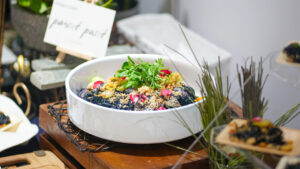THE CENTER for Culinary Arts (CCA) Manila celebrated its 27th anniversary on Nov. 29 with a culinary showcase, but also an intimate gathering of its alumni.
The CCA demo kitchen in Bonifacio Global City (BGC), a new campus inaugurated just this year in the University of the Philippines (UP) BGC complex, was transformed into a home kitchen, with four of the school’s instructors sharing their unique hometown recipes, each dish is a celebration of regional cuisine.
Kerwin Funtanilla, program manager of CCA Manila hails from Zamboanga. For his dish, he showed a Cangrejo con Salsa Alavar, blending spices and coconut milk to create a rich, flavorful crab dish that was both aromatic and visually stunning. The crabs were simmered in a fragrant sauce, and then garnished with chopped peanuts. Another chef-instructor, Miguel Lorino, presented his Cavite hometown’s Pancit Pusit, reflecting Cavite’s coastal offerings. The dish delighted the audience with its deep, dark hues and tangy vinegar-infused squid ink, topped with crispy chicharon for an added texture. Anne Atanacio, representing Rizal, brought comfort in a bowl with her Caldo ng Rizal. This was a blend of malagkit rice, chicken, and aromatic spices, garnished with hard-boiled eggs and spring onions. Finally, Jay Recio from Aklan presented Inubaran na Manok, a dish with chicken, coconut milk, spices; but especially ubod (banana pith) and libas leaves. This was garnished with chili flakes, microgreens, and edible flowers.
The presentation seems to be connected to several elements in the school’s five-year plan: according to Badjie Trinidad, President of CCA Manila, they’re in the process of fine-tuning a program exclusively for Filipino cuisine.
“Our biggest project is really doing a program for Filipino cuisine,” she told BusinessWorld at the sidelines of the alumni homecoming. The program has 16 days worth of in-person classes, and, for students overseas who want to learn about Filipino cuisine (including Filipinos abroad who want to learn more about their heritage), there are options to take it online.
Ms. Trinidad walked us through other plans for the next five years: these include the construction of a kitchen with Thames International as part of a partnership, as well as building a kitchen in the University Hotel at the UP Diliman campus. Through the years, they have developed several programs in partnership with other institutions, such as the UP Los Baños campus and the University of Asia and the Pacific (UA&P).
She credits these partnerships with the institution’s longevity, keeping in mind how they were battered during the pandemic due to lower enrollment rates. “I think it’s the community that we have. We have a lot of support from our suppliers, our alumni -— because of the network that we have, we are able to connect with people who help us,” she said. “Definitely we cannot survive just by ourselves… the support of other institutions helped us.”
While a generation in the profession benefited from the original campus at Katipunan, Quezon City, Ms. Guerrero says the fate of the former complex is still uncertain. “Right now, it’s still under discussion. Hopefully, it gets redeveloped. For now, we’re focusing on building satellite locations.”
Looking back through their almost 30 years of existence, Ms. Trinidad has a few thoughts on how educating chefs changed not just the culinary landscape, but also the country’s professional one. “When we opened 27 years ago, people didn’t really look at being a chef as a career. It was more of like just a hobby; their passion that they do on the side,” she said.
“With CCA professionalizing it, it has become a career; a career that parents are supporting right now.” — Joseph L. Garcia






